
by Dharam CW2 | Aug 11, 2023 | General
A project manager or leader is much more than someone who develops a strategy and controls all operations within a project. These experts, for example, must be skilled in communication and connection-building because the work requires them to do it frequently. The capacity to develop long-term, trusted relationships with stakeholders is a critical component of project managers’ and leaders’ success. Whether they like it or not, diverse stakeholders directly impact the business. As a result, companies with managers who can foster a deep connection with their stakeholders have a substantial competitive edge in today’s interconnected business environment.

Stakeholders
Why Stakeholders are Important to a Project
A stakeholder is an individual, group, or organization whose interests are affected by the success of a business venture or project. As the name suggests, stakeholders are interested in a project’s success. They might be internal or external to the entity funding the initiative. Stakeholder relationships may positively or negatively impact the project’s life cycle. Therefore you’ll need to identify your key stakeholders and develop a stakeholder management plan to fulfill the requirements.
Every project you manage has stakeholders, whether internal or external. One of the most common reasons for project failure is that the deliverables differ from what the customer requested or did not meet the customer’s demands. To guarantee project success, one should be familiar with the project’s main stakeholders, how they communicate their needs, and what acceptable results are.
Engaging stakeholders throughout the project, especially at the start, will assist, reduce and discover hazards and boost overall “buy-in.” When stakeholders are fully engaged, their impact is amplified. Stakeholders are vital to a project in the following ways.

Importance Of Stakeholders In Project
- Providing Expertise
Stakeholders are a source of information about current processes, historical data, and industry expertise. When gathering and documenting requirements, it is critical to include all essential stakeholders. Project managers and those in charge of deliverables may be experts on only a few projects. Key stakeholders can contribute to industry-specific needs or limitations that can be useful in identifying project constraints and risks.
- Reducing and Uncovering Risk
The more one engages and involves stakeholders in the project, the more they will decrease and identify risks. For example, during discussions, stakeholders may raise concerns regarding satisfying original specifications, project demands, and limits. Identifying risks and developing a plan to manage them before issues arise will significantly improve your initiatives’ success.
- Increasing Project Success
Stakeholders should be aware of the project scope, significant milestones, and when they will be asked to evaluate deliverables before final acceptance. Set expectations early in the project life cycle if the business must satisfy stakeholders’ demands due to competing needs or priorities. This move will assist in maintaining the relationship throughout the process.
- Granting Project Acceptance
The more frequently you interact and include stakeholders from the beginning, the more likely you will have a successful project outcome. By the end of the project, team members should be aware of delivery expectations and risks and how to reduce those risks. The final acceptance is their last stamp of approval at the project completion phase.
Stakeholder Relationships are key
Building relationships with stakeholders leads to improved trust. People collaborate more readily and successfully when there is trust. Investing time and effort in discovering and cultivating stakeholder connections may boost project confidence, reduce uncertainty, and accelerate issue resolution and decision-making. This concept recommends making a deliberate decision to devote time, attention, and effort to stakeholder relationships. In addition, personal qualities such as self-awareness, mindfulness, respect for others, and courage may be essential to developing trustworthy, open, and honest relationships.

Ways To Approach Stakeholder Relationships
How could we approach it?
- Determine the stakeholder hierarchy.
- Create profiles for individual and group stakeholders.
- Create relationship maps.
- Determine who should interact with whom and when.
- Always maintain a professional and genuine demeanor.
- Build trust and confidence through controlling and satisfying expectations, acting with integrity, honoring commitments, and being trustworthy.
- Consider how you can assist your stakeholders rather than just how they can assist your project.
Risks of overlooking this concept include:

Risks Of Overlooking Into Stakeholders Relationship Concept
- Increased project risk in terms of time, cost, and quality.
- Greater known and unknown project opposition.
- Project management is shattered.
- Reduced team motivation.
- Low cohesiveness within the project community.
- Personal and corporate reputational damage, as well as recrimination.
The benefits of applying this concept include the following:

Benefits Of Building Stakeholder Relationship
- Mutual trust and confidence have grown.
- Stress reduction and a more pleasant working atmosphere.
- Improved problem-solving and decision-making.
- Increased bid value and increased possibilities of keeping clients and employees.
- Opportunities for personal development, maturity, and career progress.
- Sufficiently prepared to deal with challenging circumstances.
- Legacy to carry on with future endeavors.
Ways to build good relationships with Project Stakeholders
Stakeholders must be effectively taken care of for any firm to succeed. These include the customers, suppliers, partners, investors, workers, and the general public interested in your company. When a stakeholder is neglected, the organization can feel the consequences. Building great connections with stakeholders requires work, time, and a well-thought-out action plan.
Building trusted relationships with key stakeholders and maintaining communication throughout your project is essential. Through active engagement and speedy resolution, engaged stakeholders motivate individuals and keep the project on track.
Project managers establish trust and interact with important stakeholders at the outset. However, as the project progresses and the team size rises, we need to catch up on the importance of maintaining those connections. If unengaged, it usually results in communication failures, a mismatch of expectations, delayed decision-making, and, in extreme cases, misaligned project goals with company strategic objectives.
Here are six suggestions for developing and maintaining effective stakeholder relationships.

Ways To Build Good Relationships With Project Stakeholders
- Identify the key stakeholders.
In every project or program, the project manager oversees the initiative and identifies all stakeholders involved in planning, status reporting, or managing the dependencies. However, the focus here is on how you engage your important stakeholders. Who are the most important stakeholders? It is determined by project type, organizational structure, industry, and internal and external relationships.
Key stakeholders in project engagement are:
- Persons who have decision-making authority.
- Influence.
- A vested interest in the project’s result.
They might be part of your project’s organizational structure (such as a project sponsor or business sponsor) or an extended stakeholder (like external customers or funding partners).
Identifying these important stakeholders early in the project allows the PM and team to build trusted relationships and understand their expectations of project deliverables, their role, and their level of engagement on an ongoing basis.
- Analyze the individual stakeholders
Analyze the individual stakeholders identified at the previous stage to determine the amount of involvement and time required to create the connection. Historical data, team brainstorming sessions, focus groups, and interviews might provide the necessary knowledge for analysis. Next, each important stakeholder is examined to determine their attitude toward the initiative, level of support, influence, and acceptance of the change.
The project manager would decide on the amount of engagement based on their interest in the project and their ability to affect change. When there is more ambiguity about the program’s scope, objectives, and expected outcome, the PM’s role in managing expectations and relationships is more significant.
- Plan on how to keep your stakeholders engaged in your project
Consider organizational culture and attitudes toward the project while developing an engagement plan. For example, understand the stakeholder’s level of support or resistance to team talks.
Define how you will assess when a stakeholder becomes disengaged as part of your strategy; the metric may be anything like the number of mandatory meetings missed by the stakeholder in a month. When a significant stakeholder consistently skips a needed meeting or fails to make timely decisions, it is a source of contention. If not handled, this disengagement will begin to undermine the project.
- Keep all key stakeholders informed and updated
The project manager is responsible for keeping all key stakeholders informed and updated as frequently and as early as feasible during the project. Therefore, maintain a proactive approach in your discussions with them.
To build a standardized onboarding process, new stakeholders should become acquainted with a collection of standard artifacts (like the charter, communication plan, business case, and risk register). Also, take the chance to hear from current stakeholders. Feedback from stakeholders who no longer have a vested interest in your endeavor may help you adjust your path.
- Maintain involvement
It is critical to maintain your involvement, especially in long-term initiatives. At the end of a project, we’ve seen project teams wear out, with stakeholders eager to move on to the next big thing. The project manager must keep the engagement going. The connections and reputation you build via this involvement can help you succeed in future efforts in large businesses. Maintain contact with your key stakeholders long after the project has been completed and delivered.
Project Management Trends That Will Shape the Future
Project management is crucial in deciding how businesses and organizations will fare in the marketplace. Projects might include implementing a corporate plan, running marketing efforts, or organizing business events. Teams work to interact, manage, and communicate as effectively as possible to complete tasks and meet deadlines.
Organizations flexibly responded to the pandemic’s disruption by developing new methods of operation. However, they were thrust into the era of digitization and had to reconsider their methods of operation. These top 6 project management trends in the future demonstrate the ongoing need for technical innovation and digital transformation regarding the function of project management software in the future by building great stakeholder relationships.

Future Project Management Trends
- AI Automation and Implementation
The use and usage of artificial intelligence are the most obvious of the new current trends in project management. Knowing which initiatives are more successful enables teams to precisely determine which aspects are vital if the firm is to reduce costs and risks. As a result, organizations may increase transparency and productivity. The main factor driving the current increase in the adoption of such software is this characteristic of project management systems.
Let’s look at a few instances:
- A few businesses currently use automated and machine learning technologies to get alerts about potential issues the company could run into. For instance, suppliers might now get notifications about possible obstacles like bad weather and traffic.
- Building machine learning algorithms to support a project manager’s decision-making capabilities by evaluating data from several projects in the project portfolio is a promising study area.
- Globalized Project Management
As working circumstances got more flexible due to the forced work from home caused by the worldwide pandemic, businesses and teams became even more globalized. It has long since established roots. Mercer estimates that 70% of businesses want to use the hybrid work model.
Although the remote work and hybrid model trend allows for the employment of creative and inventive individuals worldwide, project management has to keep up with it. Collaboration, for example, is challenging when team members are unavailable due to competing schedules created by different time zones.
Software for project management provides a tool that could address this issue. The platform enables all brainstorming sessions and discussions to take place in a single setting, allowing businesses to access talent worldwide.
- Hybrid Project Management
The third new development in project management is the rising use of the hybrid approach, which refers to how project teams combine the Waterfall methodology, the systematic approach, with the Agile methodology, which is the quick-moving methodology. A hybrid approach aims to elevate teams to become aware of the specific project lifecycle while providing the ability to support them in changing the plan as necessary.
How do you know what will work for you, and how can you prepare for this trend?
PMs must learn about the most recent techniques, examine some of the fundamentals, and analyze how to use them correctly to obtain a greater understanding of the project situation and its aspects, such as the clients, the corporate objectives, and the purpose of the project, and the team’s attitude.
There is an increasing requirement to adapt your strategy and develop a project plan that enables you to lead projects unconventionally and comprehend different components of multiple techniques that cater to the demands of your team, perceived timeline, environment, end goals, etc.
- Stakeholder-Centered design
The fourth most recent trend in project management is an emphasis on delivering transparency for the benefit of the company’s stakeholders and developing products centered on the human perspective. Project managers may communicate with, collaborate with, and inform stakeholders. This design makes it easy for investors and customers to support any project launched as part of a company’s business plan.
- Soft Skills
Soft skills have become an essential component of project management. Project managers must interact with stakeholders, clients, and project teams. They will mitigate risks, resolve internal disagreements, and keep the project team engaged. Having a high level of emotional intelligence will also be useful in project management. Therefore, organizations should begin investing in tools and programs that assist employees in acquiring soft skills.
- Predictive Data and Simulation-Based Analyses
The most difficult and demotivating aspect of managing several projects is when unanticipated repercussions jeopardize their success. Project managers seek a solution to give them the knowledge to account for the unexpected. Project teams with predictive and data analytics skills may fully use KPIs and benchmarks and execute them proactively by developing data-backed best practices.
Companies cannot afford to bear the repercussions of project failure, given the competitive environments of most markets. Therefore, projects must be started successfully to stand out from the competition. The most recent advancements in project management software demonstrate that technology will play a role in this element of corporate operations in the future. Suppose you want projects to succeed and businesses to thrive. In that case, you should consider introducing project management solutions to simplify your, your teams, and your stakeholders’ lives.
Final Thoughts
Stakeholder involvement will become essential to optimize success as knowing stakeholders becomes increasingly critical for firms. For example, stakeholder engagement may assess reactions, track public impressions of a company’s operations, and assure collaboration and partnership with all stakeholders. In addition, an organization’s long-term performance may be determined by its connections with stakeholders, which provide commitment and buy-in to future initiatives and difficulties. As a result, the company becomes more aware and responsive to the demands of all its users and stakeholders.
Stakeholder management must place a greater emphasis on involvement to move projects from installation to execution. Stakeholder management must be less hierarchically centered while considering companies’ changing political nature. Projects should begin by identifying diverse stakeholders, engaging with them consistently, and coordinating continuously to increase project success.
As a project proceeds, Stakeholder management processes need to account for the dynamic nature of stakeholders’ commitment to a project and the interactions between various stakeholders. As a result, project teams will get the competitive advantage they want by focusing not just on their stakeholder position but also on the other major stakeholders in a project and how they interact. To achieve more effective stakeholder involvement, follow these three steps:
- Create a stakeholder map and keep it updated as the project progresses.
- Prioritize essential stakeholders and regularly evaluate assumptions about commitment levels and impact.
- Create essential stakeholders and increase their commitment to the change.
Feel free to check out my discussion on this topic with Justin Buckwalter in YouTube
For any questions related to your Project Management career, training, and certifications, you can book an obligation free 15 minutes session with me by visiting talktodharam.com
You can subscribe to the vCare Project Management YouTube Channel to catch future videos of our Q&A series and certification success stories: https://bit.ly/2YF0wJl
You can subscribe to and follow my podcasts and interviews with Project Management Experts on YouTube at https://bit.ly/2NDY8wd
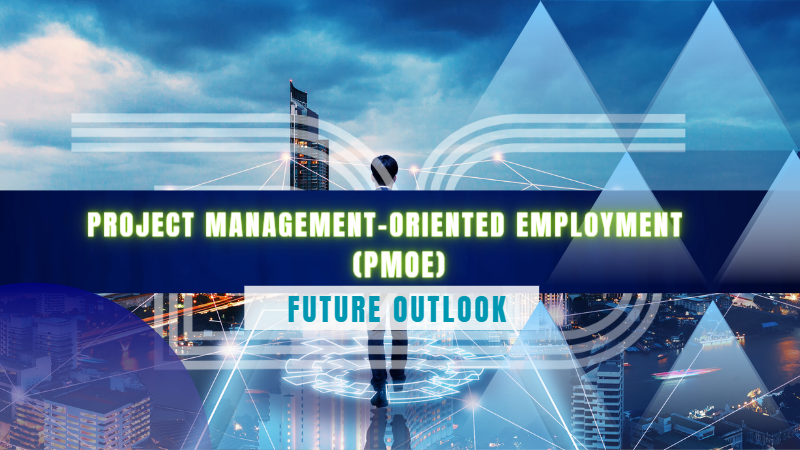
by Dharam CW2 | Jul 19, 2023 | General
Project management is a fulfilling career choice that may offer competitive pay and a wide range of job opportunities. As a result, project managers are constantly in demand: Qualified individuals are always needed to plan and provide work in every business.
Over the next ten years, demand for project managers is one of the roles which will expand faster than the need for workers in other roles. But on the other hand, organizations may face risks due to the talent gap.
Understanding PMOE
Projects are becoming an increasingly important component of business completion. The acceleration of business evolution, increasing emphasis on digital transformation, and ever-changing consumer expectations and competitor offers are here to stay. As a result, project management skills and talents are becoming increasingly important in organizations.
Organizations will not invest in training the people in those positions to accomplish that work if those roles are not recognized as contributing to project management. As a result, they will not foster an environment where employees may develop experience, and they will eventually find themselves unable to sustain the number of projects that must be delivered.
One of the reasons that technical roles are considered part of PMOE is the growing adoption of agile ways to deliver work. However, many organizations still see agile as a ‘project management free’ delivery method, where the self-organized nature of agile teams eliminates the need for project management. But, again, this thinking must change if there is any hope of closing the skills gap.
Organizations must assess their skill profiles for all roles and determine if project management competencies should be included. Even roles that do not entail daily project delivery or where employees are more frequent contributors than leaders are likely to benefit from project management skills and experience. Unless that is ‘built in’ to job profiles, hiring and development methods will remain the same, and the shortage will remain unaddressed.
Talent Gap Report 2021
Successful projects are a significant contributor to global economic growth. As more industries become projectized, the demand for qualified project managers will likely rise over the next decade.

The Talent Gap Report 2021
The Talent Gap Report 2021 has been released by the Project Management Institute. The headline is the scarcity of qualified candidates for project management-oriented employment (PMOE). As a result, around 25 million more employees will be required by 2030 than in 2019. To put this in context, there were 90 million workers in those positions in 2019, implying a 30% increase.
Simultaneously, 13 million existing project management-oriented employees will retire, with the vast majority nearing the top of the experience curve. This phenomenon implies that enterprises will lose significant knowledge and skill. And this will happen when they increase the need for that experience by introducing a large number of new project-related staff who must progress quickly. In developed economies, on the other hand, retirement is the primary source of job possibilities for younger workers.
The report’s most critical statement comes near the end: “Global demand for project management expertise is unlikely to be addressed by 2030 unless firms encourage a culture of continuous learning.” As a result, firms confront a huge growth in PMOE roles and an inability to address that requirement based on current business processes.
Addressing challenges of this magnitude demands a strategic approach backed by financial commitments and constant responsibility for performance. In some circumstances, it may also necessitate a transformation in how leaders understand their companies and roles.

3 Reasons For The Project management Talent Gap
Why and where is the Talent Gap?
There are three reasons for the project management talent gap:
- The number of positions requiring project management skills is increasing.
- Project managers are in high demand in emerging and developing companies.
- Project managers are retiring faster than young talent can replace them.
Upskill the people
Unless firms foster a culture of continuous learning, the worldwide need for project management skills is unlikely to be met by 2030. The most resilient firms will prioritize reimagined employee capability-building.
According to a McKinsey report, over 80% of business leaders consider skill building to be “very” or “very” vital to their organization’s growth, up from 59% before the pandemic. As a result, organizations will need to support new learning initiatives and seek partnerships to equip employees with the appropriate project management skills to develop their talent. These talents include power skills like teamwork and leadership; business acumen to develop well-rounded employees; and mastering new methods of working, such as growing use of tech-enhanced problem-solving tools.
Gaining a Competitive Advantage in the Talent Acquisition Race: The Front-Runners
According to PMI and PwC study, a cohort of 250 organizations face fewer challenges in attracting and retaining talent than their counterparts. Their project management offices (PMOs) are better connected with corporate strategy—three quarters have a C-suite presence, and 90% are seen as strategic partners by their executive leaders. As a result, they have an easier time recruiting people with important project skills. They are more successful at developing project managers. They are also twice as likely to have outperformed in revenue growth, customer acquisition, customer happiness, and environmental, sustainability, and governance (ESG) indicators.
Facilitating project-based organizations
The concept of stable operations is unlikely to exist at any scale by 2030, which is one of the most important factors driving the demand for more individuals in PMOE roles. The rapid growth of technology has resulted in much shorter lifecycles for both customer-facing and internal solutions. This trend is expected to continue as digital transformations drive organizations to the point where technology is vital in managing every business area.
Future of project management
Project management is being massively disrupted by management technology. As a result, forward-thinking professionals are questioning how to effectively prepare for the upcoming tidal wave of change caused by technological innovation.
Here are four skills that project managers of the future might need:
- Data Science
- Conflict resolution
- Entrepreneurship
- Resource management
Project Management’s Future in the Age of Advanced Technology
Because of emerging trends such as remote teams, digitalization, and automation, project management has changed dramatically in recent years. As a result, companies now rely significantly on technology to plan, execute, and monitor work. As an example:
- Big data and artificial intelligence for better risk forecasting
- Remote progress tracking using digitization technologies
- Automation software for more efficient execution
These innovations have improved firms’ management capacities and altered project management’s future. According to Gartner research, 80% of management duties will be automated by 2030, and future managers will need more technological abilities. They must be knowledgeable about cybersecurity, blockchains, machine learning, and robots, all of which are expected to play larger roles in management.
Future Trends of Project Management
Consider project management ten years ago: fewer tools, smaller teams, and more straightforward tasks. Since then, the project landscape has changed dramatically, with major trends such as:
- Blockchain
- Artificial intelligence
- Sustainability
- Remote teams

Future Trends of Project Management
Trend 1 – Blockchain
More companies use blockchain technologies for management, such as when conducting dispute investigations. The capacity of blockchain to automatically update data makes it ideal for reconciling records and transactions. One of the most significant contributions of blockchain to project management will be smart contracts, which are effectively self-executing contracts powered by computer code.
Smart contracts reduce the number of key functions within the project manager’s scope, such as checking on project milestones and assigning new ones, which speeds up management processes. As a result, quicker workflow assures project completion on time and improves a company’s overall performance.
Trend 2 – Artificial Intelligence
Artificial intelligence quickly infiltrates project management systems, handling anything from predictive analysis to risk management. Because of its efficacy, AI is expected to contribute:
- $42.7 B (7.7%) to Egypt’s economy
- $135.2 B (12.4%) to Saudi Arabia’s economy
- $96.3 B (13.6%) to the UAE economy
The primary capacity of AI is to provide data insights for decision-making, which increases the agility of any given project. For example, assume a manager considers which product features to include; AI finds correlations and patterns in consumer data and then recommends which product features are more likely to sell. Such insights improve an organization’s competitiveness by avoiding commitment to poorly planned, hazardous ventures.
Trend 3 – Sustainability
Today, project sustainability is more crucial than ever. Governments and societies all around the world are demanding greener approaches throughout the life cycle of a project.
Green initiatives are cost-cutting methods from a business standpoint. For example, energy is required for project execution, and shifting to renewable sources reduces costs. In addition, this frees up resources for other essential areas, such as innovation and research. Meanwhile, sustainable practices improve a company’s brand and foster consumer loyalty.
Trend 4 – Remote Teams
Remote teams have been the norm since the advent of communication technology. As a result, businesses gain from a more diverse and borderless talent pool easily available through contracts. In addition, they spend less on office space, travel, and other administrative expenses.
As a result, it’s not unexpected that 65% of workers anticipate that workplaces will become entirely virtual over the next several years. In general, remote working arrangements enable businesses to extend their resources while increasing operational efficiency. As such, they are crucial in developing lean, competitive firms.
Skills Future Project Professionals Need
To stay up with modern project management trends, a fundamental understanding of ideas such as data science, conflict resolution, and entrepreneurship is required. For example, understanding data science may assist a manager in incorporating AI into more elements of the project life cycle.
Here’s a closer look at what these talents comprise and how they’ll stay up with future project management improvements.

4 Skills Future Project Professionals Need
Skill 1 – Data Science
Big data insights are essential management tools, particularly for large projects with extensive life cycles. Insights from previous projects show inefficiencies that guide the current project, such as the number of slack hours and their causes. Data analysis assesses progress and uncovers deviations early, such as changes in material costs and currency rates that exceed expectations. As a result, project managers must comprehend topics such as statistical inference and regression analysis.
Skill 2 – Conflict Resolution
Today’s projects are extremely complicated, with constantly changing deliverables. As a result, conflicts are never far away. These issues, if left unaddressed, can undermine the team’s performance, resulting in delays and missed deliverables. Managers must thus grasp the various aspects of conflict resolution, such as:
- A conducive work environment’s behavioral and organizational components
- Effective communication
- Effective contingency planning
Skill 3 – Entrepreneurship
Project managers are, in essence, CEOs. On the one hand, they manage project deliverables. Yet, simultaneously, they negotiate with shareholders and set goals based on estimates. As a result, being effective requires more than technical and administrative skills.
Entrepreneurial skills, such as strategic thinking and market insight, are also required of project leaders. Such skills are especially important when modifying deliverables, typical in agile projects like software development.
Skill 4 – Resource Management
Budgets and timeframes became tighter as projects became larger and more complicated. Today’s project managers must balance budgetary constraints, quality delivery, and achieving deadlines with limited resources. They are entrusted with creating a lean organization.
For optimal efficacy, a precise balance of resource allocation is required, as over-allocation to one activity inhibits the others. As a result, managers must understand resource management principles such as equilibrium shifts and flexibility.
Bridging the talent gap
The PMI Talent Gap report delves into a decade’s worth of project management-related job trends, costs, and global implications. PMI has completed its most recent study of the “projectized” businesses that leverage these talents better to understand talent and employment trends in project management. Using data from selected areas, the PMI Talent Gap report provides a birds-eye perspective of the most in-demand talents and the magnitude of the talent shortfall.
PMI data shows a continuing gap between the global demand for project management skills and talent availability. This data translates into many new career prospects in PMOE for job-seeking project professionals. However, the skill shortage is a significant issue for firms that rely on project leaders and changemakers. For example, by 2030, this skill gap is anticipated to affect every area, resulting in a potential global GDP loss of up to US$345.5 billion.
Here is a summary of the top three reasons for the skill gap, as identified by PMI research and explained in the report:
- An increase in the number of professions that need project management expertise.
- Economic growth drives demand for project managers in emerging and developing countries.
- The rate of labor-force retirement
Final Thoughts
Project management has a bright future. There is still a high demand for change agents. PM will transition from being viewed as an administrative function by some executives to the strategic partnership that it has the potential to be in every organization, not just those enlightened businesses with high levels of program management maturity.
For many years, the skills of project managers have migrated toward “soft” skills. However, given how the future of work is shaping, this will become much more important. Project managers will need to be team players. As a result, we’ll need to interact with people who have the skills that the technical companion lacks:

Skills That The Technical Companion Lacks
- Empathy
- Strategic thinking
- Fun
- Creativity
- Motivation and persuasion
- Thoughtful customer service
- Listening
Feel free to check out my discussion on this topic with Justin Buckwalter in YouTube
For any questions related to your Project Management career, training, and certifications, you can book an obligation free 15 minutes session with me by visiting talktodharam.com
You can subscribe to the vCare Project Management YouTube Channel to catch future videos of our Q&A series and certification success stories: https://bit.ly/2YF0wJl
You can subscribe to and follow my podcasts and interviews with Project Management Experts on YouTube at https://bit.ly/2NDY8wd
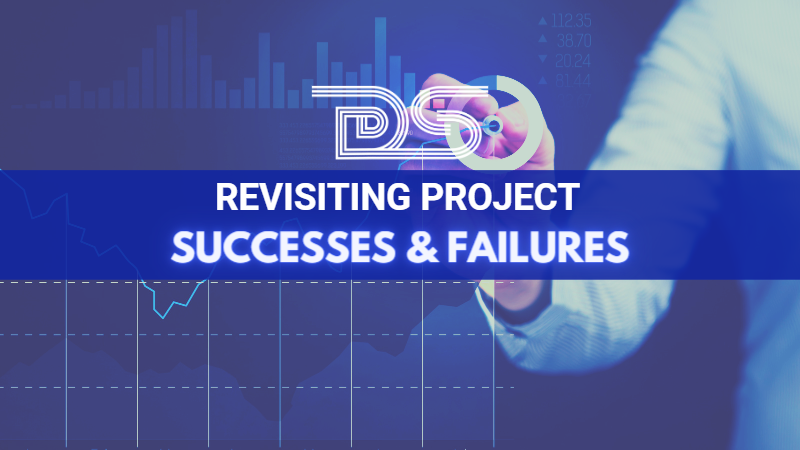
by DharamCW | Jan 15, 2023 | General
A project can be a complex, nonroutine, one-time effort constrained by time, budget, schedule, satisfaction, quality, and scope to meet the customer’s needs. Today, many businesses prioritize project management because it focuses on meeting project objectives and achieving them successfully. Moreover, it got significant because it employs managerial processes and tools that give managers a good chance of achieving their project’s goal.
Project Management Today
Project management has become an essential part of various industrial segments because it crosses corporate and geographic boundaries, adapting to the unique characteristics of various businesses and teams. Here are some of the project trends on the project’s success/ failures.
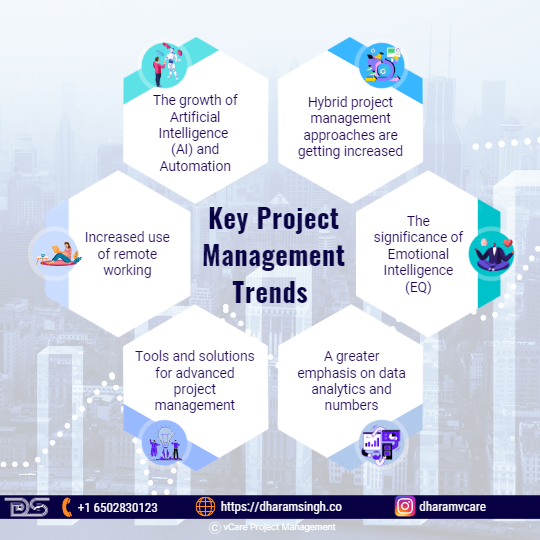
Key Project Management Trends
The Most Important Project Management Trends for 2022
- The growth of Artificial Intelligence (AI) and Automation
- Hybrid project management approaches are getting increased.
- The significance of emotional intelligence (EQ)
- A greater emphasis on data analytics and numbers
- Tools and solutions for advanced project management
- Increased use of remote working
Key Project Management Statistics 2022 (Success and Failures)
Project Success Statistics
- Project management software is used by 77% of high-performing projects. (Hive, 2020)
- 35% of organizations are somewhat satisfied with their project management maturity level. (Wellingtone, 2020)
- 29% of projects are completed on time (Wellingtone, 2020).
- Surprisingly, 54% of organizations lack access to real-time KPIs (Wellingtone, 2020).
- Around 51% of organizations complete projects that meet the business objective or original goal. Meanwhile, 52% of organizations complete projects that meet the needs of stakeholders (KPMG, 2020).
Project Failure Statistics
- COVID-19 had a moderate or significant impact on 58% of organizations, causing project delays and cancellations (KPMG, 2020).
- Organizations with low-value delivery maturity have a project failure rate of 21%, which is significantly higher than the failure rate of organizations with high-value delivery maturity, which is 11% (PMI, 2020).
- 25% of organizations do not use technology suitable for team collaborations on informal projects, despite consuming 20% of their productive time at work (Wellingtone, 2020).
- The most challenging obstacles to implementing agile techniques in an organization are resistance to change (48%), a lack of leadership participation (46%), and inconsistent practices across teams (45%). (Digital.ai, 2020).
- 47% of agile projects are late, have budget overruns, or have dissatisfied customers (Scrum, 2021).
- Understanding these statistics allows project professionals to prepare better for what comes next and make more informed decisions.
Success and Failure of Projects
The business environment is constantly changing, and meeting the customer’s ever-changing needs has become challenging. In addition, customers’ expectations increase as competition in the global market increases. This is sometimes reflected in the pressure that Project Managers face when attempting to provide the best possible value to their customers.
While project management is constantly improving, there are some challenges for which solutions have yet to be found. Global projects are typically getting complex, and as a result, a similar project may be successful in one part of the world while failing in another. Let’s look at the factors for successes and failures on similar projects, as well as how leadership style can help to improve project performance as a contributing factor to the project’s outcome.
Causes of project failure
A project is considered a failure if it fails to deliver on time within the estimated budget. Most project managers have felt the agony of a failed project. In fact, according to a Pulse of the Profession® survey 2021, 12% of projects in an organization failed in the previous year.
When a project is considered a failure?
- First, the project did not meet the expectations.
- The client did not receive the desired deliverable.
- The work was not finished on time.
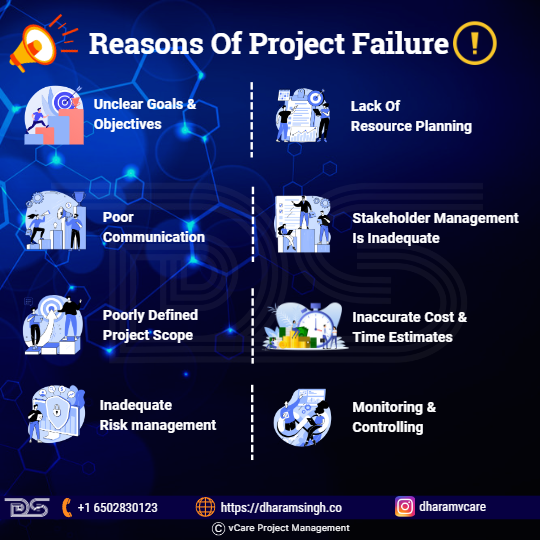
Reasons of Project Failure
So here’s to planning ahead of time and avoiding these common project pitfalls.
- Unclear Goals And Objectives
Businesses that fail to set clear employee goals and objectives waste significant time and effort. The following are the consequences of ambiguous project goals and objectives.
- Unclear objectives lead to ambiguous operational methods.
- Individually, the level of performance can be justified.
- It’s not always obvious when a project deviates from its original path.
- People involved in a project cannot work to their full potential.
- Lack Of Resource Planning
In project management, resources refer to people, money, and materials. Human resources are likely underutilized or overworked if you do not use a good task management tool.
Another critical aspect of project resource planning is financial planning. Projects with poor cost estimation and inconsistent tracking will almost certainly go over budget. In addition, project managers who do not understand how to track and manage finances are more likely to fail the project.
- Poor Communication
Poor communication in the workplace can have disastrous consequences for the project, including poor collaboration and decreased productivity, resulting in stressed employees, dissatisfied customers, and workplace mistrust.
Whether it’s delayed communication, a lack of communication, or no communication at all, the fact is that the project is likely to fall through the cracks if the project professionals don’t have an effective communication strategy in place.
- Stakeholder Management Is Inadequate
Stakeholders have an inherent interest in the project, for better or worse. Project managers are responsible for identifying and communicating with all stakeholders promptly and without delays. Unfortunately, there are numerous reasons for poor stakeholder management, some of which are listed below.
- Stakeholders are too narrowly defined.
- Failure to strike a balance between compliance and strategic opportunities
- Stakeholders are prematurely removing resources.
- Stakeholders’ disinterest
- Stakeholders are unaware of the project’s progress.
Engaged stakeholders provide support and insights to help a project succeed, whereas disengaged stakeholders can become barriers to success.
- Poorly Defined Project Scope
The project scope details everything you intend to do (and not going to do). In project management, scope creep refers to uncontrolled, continuous changes in the scope of a project. Conversely, a poorly defined project scope leads to scope creep, where the former is vaguely defined, documented, or controlled.
A project with an unclear project scope is more likely to fail and encounter a variety of issues, including:
- Failure to meet customer expectations
- Continual changes are being requested throughout the project’s life cycle.
- The budget exceeds the allocated budget.
- Failure to meet deadlines
- Inaccurate Cost And Time Estimates
Inaccurate cost and time estimate frequently result in team members making accurate predictions about the expected duration of tasks and the project’s cost based on an average duration of time and cost for previous projects.
Inaccurate estimates are frequently the result of two underlying causes:
- Upfront planning
- Poor estimation practices
- Inadequate Risk management
Risk management enables project managers to identify and analyze issues that may arise during the project and impede its progress. If risks are not effectively managed, they will likely emerge during the project’s later stages, causing significant scope creep. Conversely, poor risk management can lead to project delays, low user adoption, late assignments, overspent budgets, and project failure.
- Monitoring And Controlling
Monitoring and controlling the project is one of the lesser-known facts that project managers and their teams often overlook. However, a project manager needs to “track, review, and regulate the project’s progress; identify areas that require changes in the planning, and initiate the corresponding changes.”
Every effort should be made to keep the project on track, and if it falls behind budget or schedule, the plan should be adjusted to get the project back on track.
How to Recover a Failing Project?
Three key questions you can ask to quickly and clearly understand the project.
- Are the problems internal or external?
You can determine whether the source of the problem is internal (and thus correctable) or external (outside of your control).
Review project documents such as the charter, plan, and schedule for:
- Requirements from relevant stakeholders.
- A reasonable timetable with attainable goals.
- Allocation of resources
- A method of collecting and managing change requests.
- Unexpected expenses (internal and external).
- Success metrics.
- A procedure for upholding quality standards.
- Why are we behind schedule?
Next, determine why the project is running late.
- Were tasks properly prioritized?
- Were tasks clearly explained?
- Was the timetable overly ambitious?
- How frequently did the project manager provide status updates?
- Who made important project decisions?
- Is there a record of decisions and change requests?
- How were risks communicated and addressed?
- Was the initial budget adequate?
- Is the team working effectively?
Finally, consider how well the team worked together.
- Did the team understand the project’s goal and its roles and responsibilities?
- Was the team using the same procedures and tools?
- Did the team meet regularly to share updates and challenges?
- Was a clear communication strategy in place?
- Were the right people assigned to the project?
- Were there any issues with suppliers or vendors?
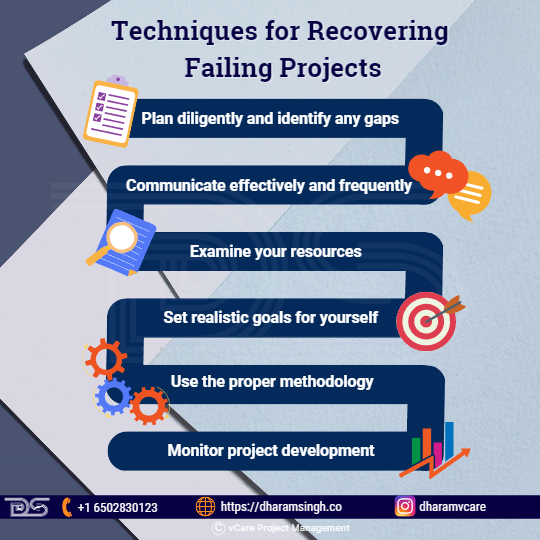
Techniques for Recovering Failing Projects
Techniques for recovering failing projects
While failures are unavoidable in project management, project professionals can always learn from the failures to succeed in the future. So, let’s look at how project managers can ensure that their next project runs smoothly and that any potential problems are identified and resolved before they become too large to cause project failure.
- Plan diligently and identify any gaps.
- Communicate effectively and frequently.
- Examine your Resources
- Set realistic goals for yourself.
- Use the Proper Methodology
- Monitor Project Development
Strategic alignment in project management
Strategic alignment in project management refers to aligning project goals with your organization’s long-term vision and mission.
Contrary to popular belief, strategic alignment in project management does not only refer to establishing and maintaining key financial metrics. Instead, it’s a broad concept that encompasses everything from key financial and quality indicators to customer satisfaction, brand recognition, and value proposition.
Every project has a goal. While some may seek to provide a service or product, others may seek intangible benefits such as positive customer relationships or company goodwill. These strategic goals guide a project professional’s day-to-day business operations and help them turn their ideas into desired results.
Importance of Strategic Alignment in Project Management
- Focus the energy in the right place
- Allow for productive team collaboration
- Describe the organization’s competitive advantages
- Manage priorities that conflict
- Avoid duplication.
- Accept market manoeuvrability
Leadership performance is significant to project success
Effective leadership in project management is the ability to persuade people of the need for change, stimulate new ways of thinking and problem solving, and encourage them to achieve project objectives. Leadership also guides team members to grow as professionals while completing their project responsibilities.
Today’s evidence-based theories of leadership can be characterized into six major classes, which include:
- Attributes
- Behavior
- Contingency
- Visionary
- Emotional intelligence
- Competency
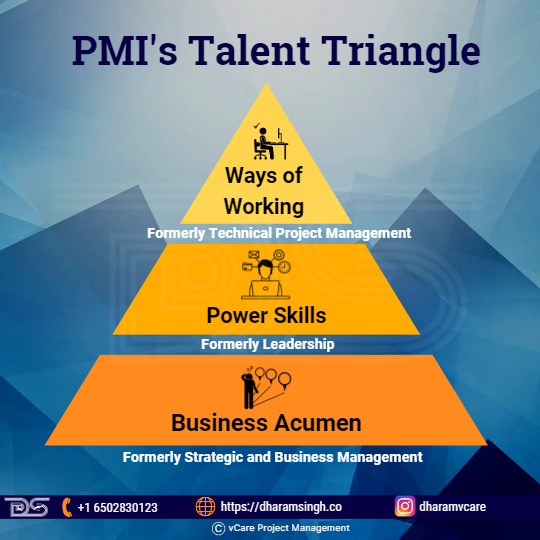
PMI’s Talent Triangle
PMI’s Talent Triangle – How to Stand Out as a Successful Project Manager
Project managers must be more agile and resourceful than ever to keep up with and make an impact in a fast-changing world. PMI has always been dedicated to assisting project professionals in developing strong skills. Nonetheless, project managers now require a skill set that includes a variety of disciplines and practices, as well as other in-demand skills.
To assist project professionals in navigating this changing world of work and embracing smarter ways of working, project professionals need to focus on:
- Ways of Working: Formerly Technical Project Management
- Power Skills: Formerly Leadership
- Business Acumen: Formerly Strategic and Business Management
Factors of project success
Project success has been defined as a project that meets its objectives on time and within budget. A development project’s success extends beyond meeting schedule and budget objectives. It also includes meeting the expectations of beneficiaries, stakeholders, donors, and funding agencies. However, defining these dimensions of success is more complicated and can only be assessed years after the project is completed.
Measuring project success after the fact is important because it aids in determining future strategies when planning new projects. Continuous improvement based on data from past projects enables project managers to identify problems before they occur. Using past data allows new processes to be implemented with fewer errors and greater management success.
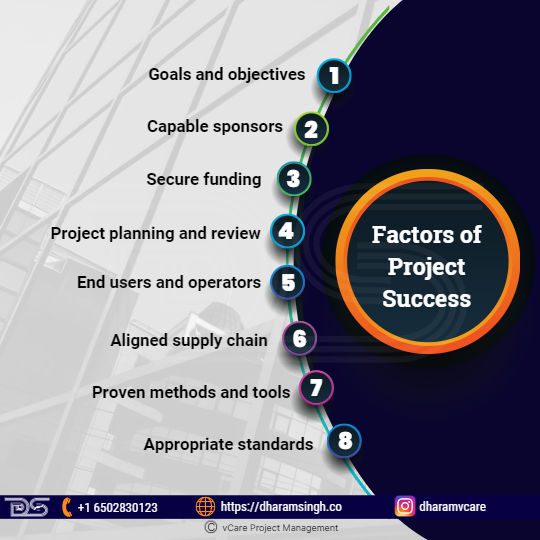
Factors of Project Success
Here are some of the factors for the project’s success:
- Goals and objectives
The project’s overall goal is specified and recognized by all stakeholders; it is not at odds with subsidiary objectives, and project leaders have a clear vision of the project’s outcomes.
- Capable sponsors
Sponsors play an active role in the project’s life cycle; they bear ultimate responsibility and accountability for the project’s outcomes.
- Secure funding
The project has a secure funding base; contingency funding is recognized from the start, and budgets are strictly regulated to ensure maximum value is realized.
- Project planning and review
Pre-project planning is thorough and considered; progress is monitored regularly and carefully; the project has realistic time schedules, active risk management, and a post-project review.
- End users and operators
End users or operators are involved in the project’s design; the project team works with users who can effectively and efficiently implement what the project has produced.
- Aligned supply chain
All direct and indirect suppliers know the project’s requirements, timelines, and quality standards. As a result, the supply chain’s higher and lower tiers are coordinated.
- Proven methods and tools
Good project management tools, methods, and techniques are used to maintain an effective balance of flexibility and robustness.
- Appropriate standards
Quality standards are actively used to drive output quality. In addition, other standards are regularly monitored to ensure delivery at the best practice levels.
Knowing what success factors are important at the end of a project is critical for assessing how that project went and making changes for the next one. It is critical to understand what distinguishes success from failure.
By investing time in learning about the future of project management, project professionals will be better prepared to capitalize on new opportunities and develop their skill set accordingly. So many opportunities for growth and success are on the horizon; use these trends and factors to propel your company, projects, and team to new heights!
Feel free to check out my discussion on this topic with Thomas Walenta in YouTube
For any questions related to your Project Management career, training, and certifications, you can book an obligation free 15 minutes session with me by visiting talktodharam.com
You can subscribe to the vCare Project Management YouTube Channel to catch future videos of our Q&A series and certification success stories: https://bit.ly/2YF0wJl
You can subscribe to and follow my podcasts and interviews with Project Management Experts on YouTube at https://bit.ly/2NDY8wd
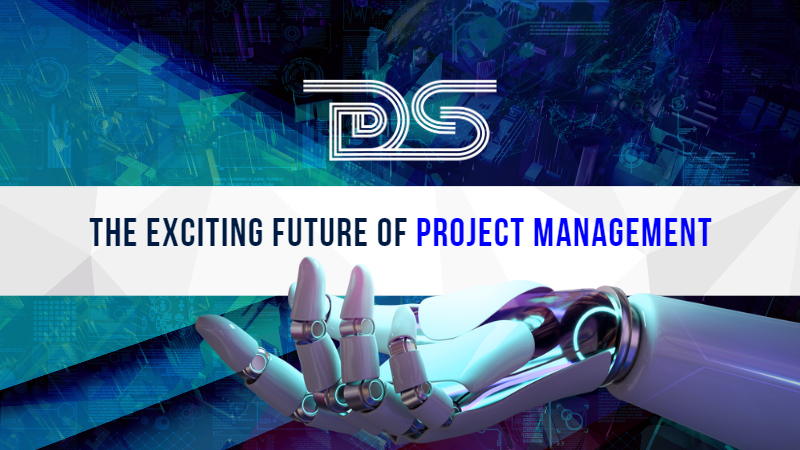
by DharamCW | Nov 28, 2022 | General
Project management “is the application of tools, knowledge, processes, and competencies to ensure the successful completion of a project.” Projects are time-bound endeavors that seek to generate value through products, services, or outcomes that meet the project’s objectives and success parameters.
Project Management Institute (PMI) defines project management as “the use of specific knowledge, skills, tools, and techniques to deliver something of value to people.”
Project management is leading a team’s work to achieve all project goals within the constraints set. The primary rules are scope, time, and budget. The secondary task is to optimize the allocation of required inputs and apply them to achieve predefined goals.
Project managers are essential to a project’s success and are in high demand. They employ various skills and knowledge to engage and motivate others to achieve the project’s objectives. By 2027, employers will need 87.7 million individuals in project management-oriented roles as per the “Job Growth & Talent Gap 2017-2027” report.
“The Future of Project Management By Harold Kerzner, Ph.D., and J. LeRoy Ward International Institute for Learning (IIL)” article discusses four new principles to determine what types of project management training we believe are available to project managers in most of today’s successful business models.

Four Principles of Project Management Training
- First and most importantly, project management is now viewed as a business process in which project managers are expected to make business and project-related decisions.
- Second, project management is no longer viewed as a collection of operational or tactical activities to produce a deliverable or outcome.
- Third, project management is now a delivery system for achieving the desired business benefits and value.
- Fourth, project management is no longer just another career option within a company.
As more and more digitization is growing, project management has never been as exciting as it is now. The overall trend is an increase in the need for project managers. Project management is no more a job that deals with Gantt charts and ticking off a checklist.
Project management has always been a great profession to be in. It allows one to work with people, deal with risks and conflicts, and the ability to manage the outcomes for the business. It always gives you a feeling of importance and provides the opportunity to take leadership to drive the business goals. It greatly enhances your soft skills and helps you work with people to improve their capabilities along the project.
Apart from this, a project management profession helps you develop yourself and constantly provides new challenges every day. As the business grows dynamically, newer challenges and opportunities are managed by the project managers of today’s times. It provides career progression in terms of becoming a project manager, program manager, portfolio manager, and so on.
Project Management Trends
The project management industry rapidly evolves with the latest trends, tools, and technologies as the changes in trends in project management are dynamic and unavoidable. Therefore, understanding current project management trends will help us stay on top of the profession or business.
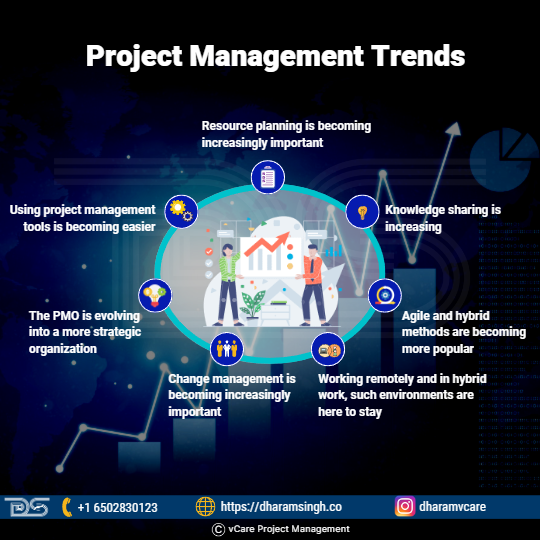
Project Management Trends
Trend 1: Resource planning is becoming increasingly important.
Trend 2: Knowledge sharing is increasing.
Trend 3: Agile and hybrid methods are becoming more popular.
Trend 4: Working remotely and in hybrid work, such environments are here to stay.
Trend 5: Change management is becoming increasingly important.
Trend 6: The PMO is evolving into a more strategic organization.
Trend 7: Using project management tools is becoming easier.
In a post-pandemic world, employing top project managers is more important than ever. Remote working, upskilling, and the pandemic’s lingering effects will shape the future of project management.
Increasing Emphasis on Soft Skills
Traditionally, the value of project managers was determined by their certifications and ability to implement various methodologies. However, many organizations are shifting their emphasis to soft skills. This project management trend is understandable, as AI-powered solutions have advanced to the point where they can handle the more challenging technical aspects of project management.
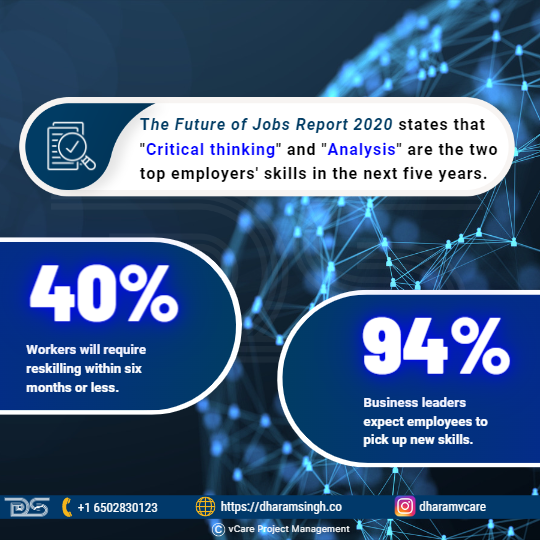
The Future of Jobs Report 2020
The Future of Jobs Report 2020 states that “Critical thinking” and “Analysis” are the two top employers’ skills in the next five years. 40% of workers will require reskilling within six months or less. 94% of business leaders expect employees to pick up new skills.
Project managers must now focus on improving their soft skills in conflict resolution, stakeholder engagement, negotiation, mentoring and training, decision-making, and team building. Practicing these skills will enable project managers to add more value to their organization.
Predictions for the Future of Project Management
“Change is the only constant,” as the adage goes. Project teams are no longer smaller, and the projects are no longer more straightforward. It appears to be true in the project management industry. The project management landscape is rapidly changing with evolving technologies, tools, and the latest trends.
Unlike the olden days now, there are a lot of tools, techniques, and methods that project managers can adopt to make the job much easier and more effective. Three major factors that would impact are:
- The Dynamically changing technology landscape.
- Increasing organizational complexity with Remote & Hybrid Work.
- Sustainability/Ecological concerns.

Factors Impacting Future of Project Management
1. The Dynamically changing Technology landscape
We will look at how the future of project management is evolving and exciting as the future holds concerning some of the changing technology components which are emerging.
a.) The growth of Artificial Intelligence (AI) and Automation
According to the Project Management Institute, 81 percent of professionals believe that AI impacts their organizations. Project managers are given a chance to focus their efforts and energy on tasks that will most significantly benefit their businesses. Automation can help project managers to effect more significant change and increase the chances of each project achieving its strategic goals.
By 2030, AI will have taken over 80 percent of the work of today’s PM discipline, including data collection, tracking, and reporting (Gartner, 2019).
PMI’s Pulse of the Profession report emphasizes the importance of data science skills, an innovative mindset, security and privacy knowledge, legal and regulatory compliance knowledge, the ability to make data-driven decisions, and collaborative leadership skills.
According to PwC’s ’22nd Annual Global CEO Survey, in the next five years, 85 percent of CEOs believe AI will significantly change how they do business. Even though it is still in its early stages of development, AI can be used in project management to reduce highly complex issues and play a significant role in their success.
In recent years, organizations have adopted AI on a larger scale to ensure successful project completion in a variety of ways, including:
- Producing performance insights
- Assisting in decision-making processes
- Estimating and forecasting
- Optimizing resource allocation
- Making data visualization possible
- Conducting risk analysis
AI with chatbots can even be integrated for project management reports and status on tasks. Also, the status can be updated from anywhere and anytime. It can help as an intelligent project assistant. Already products like PPM Express are working in this space. In construction and engineering space, AI can be used for monitoring sites and site inspection with the help of OpenCV, Drone cameras, etc. Large enterprises are using AI for intelligent resource deployments for projects.
b.) Rise in Data Analytics Focus for Data-Driven Project Management
Every day, organizations of all sizes generate massive amounts of data as it is only logical to use that data to notify decisions. Data analytics and reporting can assist project managers in identifying early signs of scope creep, calculating project progress rates, and other tasks.
AI-powered analytics provide a comprehensive picture of the entire organization and all projects. They provide granular visibility into activities and generate custom reports to assist project managers in visualizing data as required. With these tools, project managers can make informed decisions in real time rather than making gut-based decisions based on manually compiled reports.
c.) Advanced Project and Resource Management Tools
According to a 2020 report from Wellingtone, 54 percent of organizations lack access to real-time KPIs for their projects, and more than a third spend more than a day collecting data. This result demonstrates that project management tools can no longer be overlooked. When combined with AI-based automation capabilities, project management software can positively change how organizations manage their projects, regardless of their complexity.
Project managers of the future cannot survive without digital skills. The learning and experience on these tools will help appropriately present data and enhance decision-making with stakeholders. Current project management tools have become digital. Collaboration is seamless. For making effective decision making, the project managers need to have a good hold on the areas like the following:
- Data analysis, analytics, and management
- Security and data protection
- Legal and regulatory compliance
- Online collaboration and leadership (JIRA, Confluence, etc.,)
- Knowledge management (Sharepoint, Google Docs, etc., )
- Data-driven decision making. (BI Tools – Power BI, Tableau, etc.,)
Here are some examples of how the appropriate software can make a significant difference in future project management:
- Use historical project data to improve bids and plans for future projects.
- View resource availability, skills, and other details to make resource allocation easier.
- AI can automatically track all time spent on tasks and projects.
- To stay on top of finances, quickly allocate and track budgets.
- In real-time, capture all expenses with invoices for all projects.
- Track all projects using customizable dashboards to make better quick decisions.
- Maintain real-time communication with all stakeholders and team members about the project’s status, progress, and changes.
d.) Internet of Things:
The Internet of things is a network of electronic sensors and actuators that can help interact with each other and exchange data for numerical applications. We already see its application in the form of Alexa, Digital watches, Smart Vending Machines, and many more. The Internet of things can provide useful real-time data and help in various ways in project management. Assuming you are working on a team or sensitive project with technical and regulatory characteristics that need real-time data with a higher speed of reporting. IoT can help improve process control and also manage the explosion of valuable data on the project from sensors and devices. Project Managers can use these IoT technologies to reduce the workload in collecting data and streamline the reporting efforts.
e.) Digital Twins:
The Internet of things has been evolving, and it has been contributing to a lot of industries in terms of monitoring, real-time analytics, etc.; Projects involving Infrastructure, Construction, and industries would need a lot of physical presence. Digital twins can work with CAD and BIM (Building Information Modeling) data sets. Projects executed on these domains also call for ensuring the safety of the stakeholders involved in the project. In such scenarios, a digital twin can provide digital replicas of the physical objects or the location, which can encompass the project’s design and engineering aspects, which should help minimize travel/physical presence at the engineering sites. This action would also greatly enhance the better visibility of the sites in digital means for faster and more responsive actions on the project, yet contributing to sustainability via fewer carbon footprints. Digital twins provide intuitive visuals of the project situation with context and help to make decisions faster.
2. Increasing organization complexity with Remote & Hybrid Work
Remote working was already popular, but it has skyrocketed to unprecedented levels in recent years. While the global pandemic forced organizations to allow employees to telecommute due to safety concerns, remote work tends to continue for the foreseeable future. This aspect presents some intriguing challenges to project managers. According to Forbes, up to 97 percent of employees are unwilling to return to their offices full-time.
There have been renewed efforts in the post-pandemic era that many organizations have begun to experiment with a hybrid approach that combines elements from two or more methodologies. It is no longer just about agile, scrum, or lean but about combining specific attributes for increased flexibility in driving project success. This approach has enabled organizations to develop distinctive approaches to particular industries and projects.
The hybrid concept extends to the development of project team structures. The Capterra report states that 37% of teams are cross-functional and led by a dedicated PM. Cross-functional teams can share their department’s best practices for the project team to decide whether they want to incorporate them into their processes.
Hybrid project management is evolving. Projects are complex with a mix of technology, domain, people, process, and tools. Many organizations are not even ready for such a change to adapt themselves. Based on recent research by IPMA(International Project Management Association), only 47% of organizations are using agile approaches. Situations like the COVID-19 Ukraine-Russia conflict are making the environment more uncertain. Geopolitical situations can put countries and global projects at risk, increasing the challenges for project managers to be dynamic and responsive.
The project managers have to address problems like the following, which could be exciting and challenging:
a) More collaboration with contractors and suppliers
b) Higher staff turnover
c) Stakeholders having competing demands and expectations
d) Need for decisions taken faster
e) Increasing complexity in regulations and governance
Due to the inherent nature of dynamic technological changes, there is a need to manage constant training/coaching for the project members involved. This context keeps the project manager and project executives current and on the learning curve. In the future, project managers will be successful if they break the typical corporate mindset. They will be the ones who work with a hybrid approach and mindset. The term “hybrid” refers to the ability of the Project Manager to take an adaptive approach to the multiple roles and provide value with cross-functional/diverse teams.
Though technology plays a central role in project management, the project managers are expected to have great levels of emotional intelligence to manage the project members. The Project Manager needs to maneuver through social skills and empathy. This move would greatly contribute to the productivity and quality of the projects.
3. Sustainability / Ecological concerns
Project managers have to become socially responsible in alignment with the organizational culture, structure, and processes, starting with environmental analysis as per the PMBOK Guide. It would be exciting for the project managers to contribute to sustainability by adding the sustainability objectives to the project charter apart from the financial business case. This action might call for additional training on aspects like sustainability LCA(Life Cycle Assessments).
From sourcing to day-to-day operations in the project, the project manager needs to consider minimizing the carbon footprint, and it’s no more a thing specific to governments. Sustainability involves balancing different concerns:
- Environment, such as climate change
- Society, such as community
- Economy, such as affordability
- Administration, such as health and safety
When these four elements are considered, we can build sustainability into projects. (Reference: APM Body of knowledge 7th Edition)
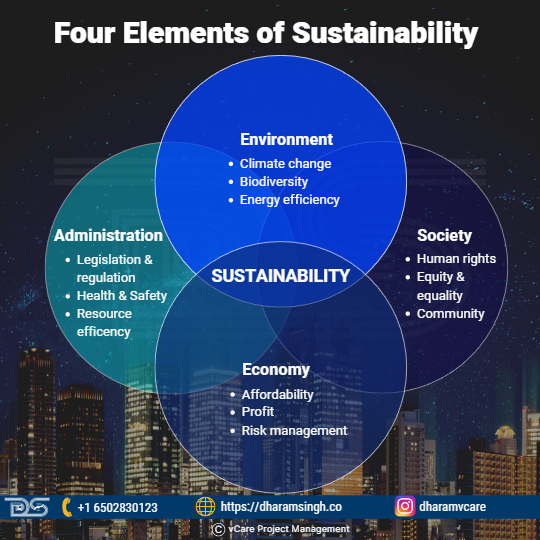
Four Elements of Sustainability
Project managers need comprehensive risk management when it also calls for transparent project communication. Especially when it comes to a project with a high level of material handling, sustainability aspects in terms of procurement from the right suppliers, verification of the sources, material origin, quality of the material, etc., would come into context. Project managers must look from all the above perspectives to make sustainable project management a reality.
Conclusion
The project management profession has come into an exciting phase as it’s more challenging and has more tools to make it easier. Only with an appropriate level of training on the tools and adoption of emerging trends would project managers be able to sustain it. The project managers’ skills move in the direction of having focus, multi-skill leadership, emotional intelligence, change management, and negotiation skills. Achieving certifications would be to have an aspect to prove your credentials and have a structured approach to your thought process complementing your experience and skills in these areas outlined in this article.
Understanding current project management trends and predicting the future of project management is critical for staying on top of the profession. Considering the predictions, the future looks bright for those who can adapt to changing trends by expanding their knowledge of new tools and techniques and pursuing accreditation for project management in their specific industries.
Feel free to check out my discussion on this topic with Thomas Walenta in YouTube
You can subscribe and follow my podcasts and interviews with Project Management Experts on YouTube at https://bit.ly/2NDY8wd
You can subscribe to vCare Project Management YouTube Channel to catch future videos of our certification Q&A series and student success stories using the link https://bit.ly/2YF0wJl
For any questions related to Project Management career, training, and certifications, you can book an obligation free 15 minutes session with me by visiting talktodharam.com































Recent Comments